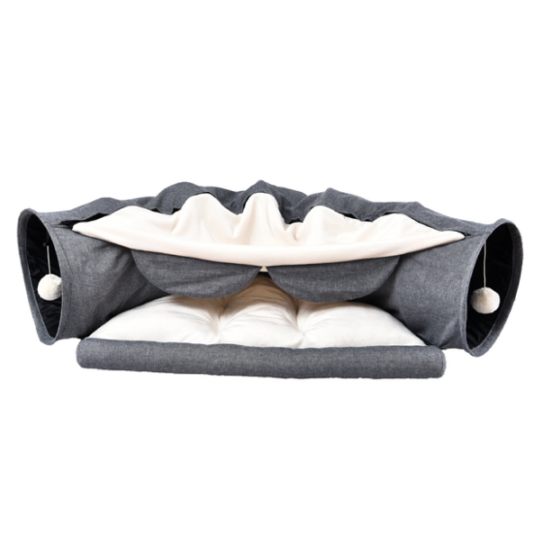Last Updated: 06/05/2025
Russian Blue Complete Breed Guide
Wondering whether a Russian blue would make a good addition to your family? Take a look at our comprehensive guide for facts and care tips.
Author: Dr Lacey Kelly BVSc (Hons)
Reading Time: 4 minutes - short read
A complete breed guide for the Russian Blue cat
With their flawless blue coat and striking green eyes, you are sure to turn heads if you decide to bring a Russian Blue into your home. The Russian Blue is an excellent choice for allergy sufferers. Not only do they shed less than most cats, but they also produce lower levels of the allergen glycoprotein Fel d1. If you are looking for a well-tempered, loyal cat with a unique look then the Russian Blue may just be the one for you.
Contents:
Russian Blue Facts
| Place of origin: | Life expectancy: | Other names: |
| Russia | 12 - 20 years | Archangel Blue, Archangel Cat |
| Energy level: | Tendency to vocalise: | Coat colours: |
| Moderate | Low | Blueish-grey tones; ranging from silver to deep slate |
| Coat type: | Size: | Coat markings: |
| Short-haired, dense double-layered coat | Female: 3.2-4.5 kg Male: 4.5 to 6.8 kg | No markings |
| Shedding factor: | Overall grooming needs: | Eye colour: |
| Low | Low | Green |
Russian Blue Characteristics
The Russian Blue is a small to medium sized cat, but you may be forgiven for thinking they are larger due to their very dense double coat. They are fine boned and slender with long legs, large ears, and a very regal appearance. With an upward turn to their mouths Russian Blues are known for their ever present 'smile'. They are easily recognisable with their flawless blue coat and large green eyes.
Russian Blue History

Photo via Siamese of Day.
Not a lot is known about this rare breed, however, unsurprisingly it is believed that Russian Blue cats originate from Russia. It is thought that British sailors stationed in Russia brought them back to Great Britain in the mid-1860s after becoming infatuated with them.
The Russian Blue cat made its debut into society in 1875 when it was exhibited at London's Crystal Palace as 'The Archangel Cat'. The Crystal Palace was constructed under Prince Albert as a place to exhibit 'items of interest' to the people of Victorian London; with cat shows becoming of great popularity in the middle of the nineteenth century.
After long being exhibited alongside other blue cats, the Russian Blue was given its own classification in 1912. It wasn't until the end of World War II however that they gained real popularity amongst cat lovers.
Russian Blue Personality

Russian Blues are playful, loyal, and affectionate. They enjoy following their two-legged family members from room to room but are just as happy soaking up some solo time. Their high energy levels and tolerance of children and other animals is likely why they are often described as 'dog-like'. Make sure they have a quiet, private nook to escape to when they have reached their socialising limit.
They will happily keep themselves entertained while you're at work all day but will expect a lot of play time when you return home. Interactive toys and food puzzles are a great way to keep these playful cats entertained.
Russian Blues can be particularly fastidious when it comes to their litter and if it is not up to their high standards then they simply won't use it. Multiple litter trays, cleaned after every use is the way to go with Russian Blues. If you find you can't keep up with such regular cleaning, then a litter robot is worth considering. An automatic, self-cleaning litter box ensures a clean bed of litter for your fusspot each and every time.
Top Toys and Accessories for Russian Blue Cats



Russian Blue Nutrition

Being so food oriented the Russian Blue is prone to gaining excess weight. Obesity is a significant risk factor for numerous medical conditions, so it is important to portion their food carefully. A weight-controlled or indoor dry food can help with weight management.
Dry food is beneficial for good dental health, while wet food supports your Russian Blue's kidney and bladder health. A combination of both wet and dry is recommended for optimal health.
Top Dry Foods for Adult Russian Blues
Top Wet Foods for Adult Russian Blues
Russian Blue Health Concerns

Russian Blues are generally very healthy cats, being genetically sound for the most part.
Bladder Stones
Russian Blues are particularly prone to developing bladder stones. These bladder stones or 'uroliths' form when there is accumulation of mineral sediment in the bladder. Uroliths can be formed from a number of different types of minerals, including magnesium struvite, calcium oxalate, ammonium urate, and cysteine. Some urinary stones can be dissolved with nutrition, but others may need to be surgically removed.
Obesity
These kitties LOVE mealtime! Their love of food can very easily lead to obesity, so it is important to stick to a well-balanced, premium quality diet. Make sure to measure their food and avoid excess treats. Remember obesity predisposes cats to a number of medical conditions, such as diabetes and arthritis.
Periodontal Disease
Periodontal disease is disease of the tissues that surround and support the teeth. It occurs when plaque builds up on the teeth leading to bacterial infections around the teeth. The bacteria penetrate under the gums causing them to become inflamed and occasionally bleed. Eventually the attachments that hold the teeth in place can become weakened, leading to loose and missing teeth. The risk or periodontal disease can be reduced with good dental care at home from an early age.
Further Reading
Want to know more? Check out our Discover Page for more tips from our expert vets on keeping your pets happy and healthy.